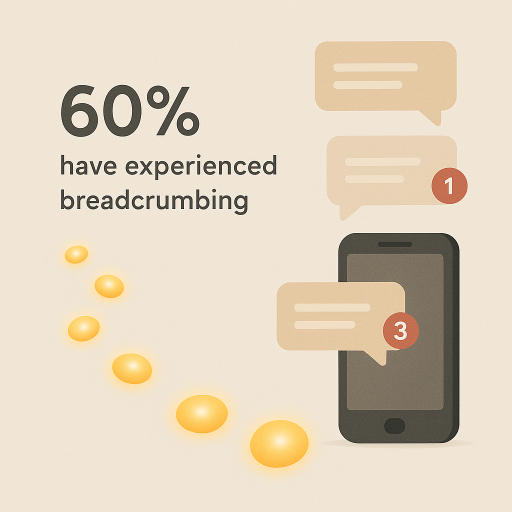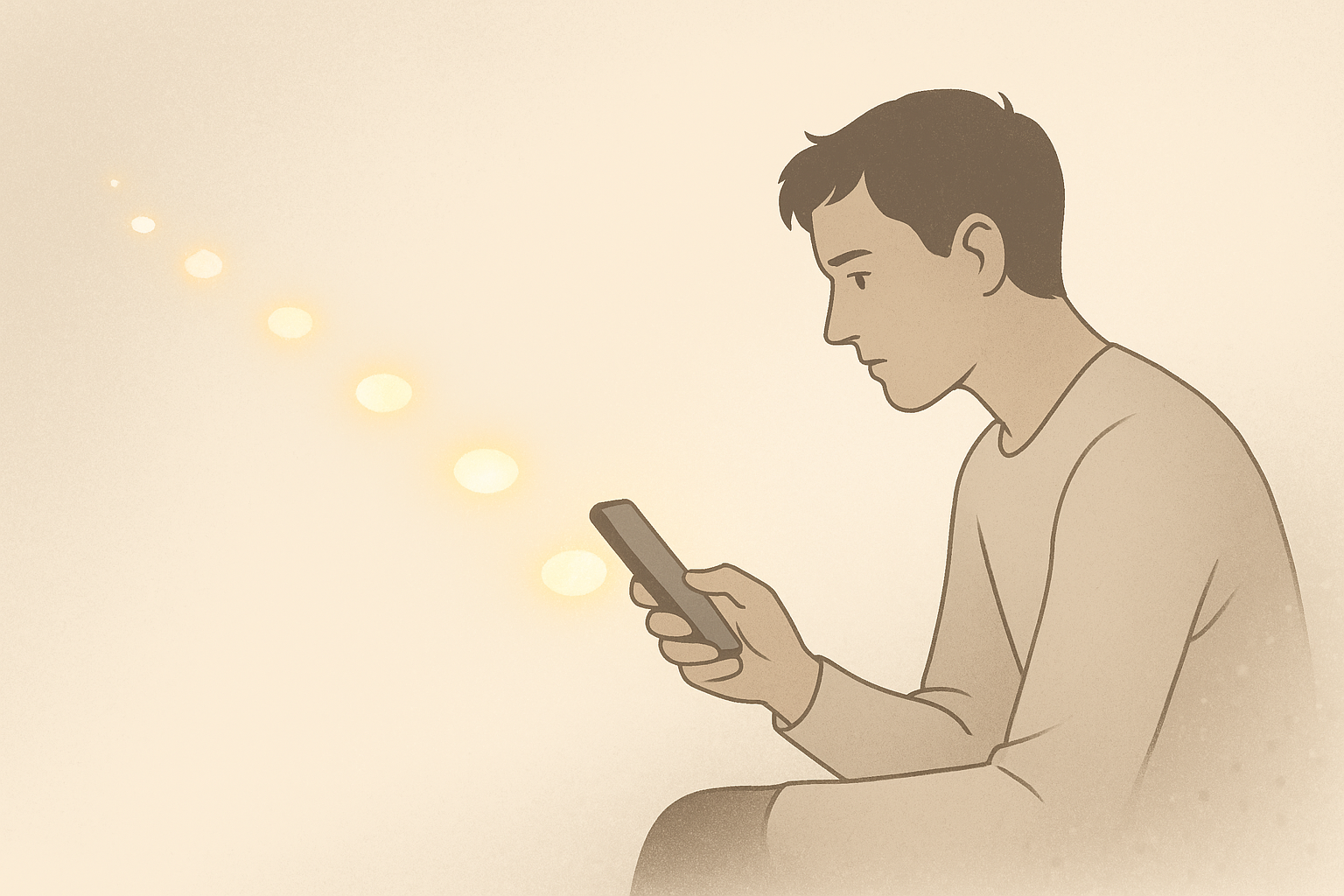You know the pattern. The good-morning texts fade into silence by noon. The flirtatious messages never materialize into plans. There’s a sudden reappearance just as you start to move on. It feels like connection, but it isn’t: it’s breadcrumbing.
Recent research suggests that nearly 60% of daters have experienced breadcrumbing in some form (Timko, 2022). It involves keeping someone interested through sporadic, noncommittal communication. This interaction is just enough to hold attention. Yet, it’s never enough to build a connection. Beneath the surface, breadcrumbing is more than just a digital dating trend. It is a psychological behavior shaped by avoidance. It is also influenced by validation-seeking and emotional inconsistency.
What Is Breadcrumbing?
Breadcrumbing is the act of sending flirtatious, intermittent messages. These gestures lead someone on without the intent to pursue a genuine relationship. Unlike ghosting, where communication ends abruptly, breadcrumbing maintains just enough contact to keep hope alive.
Psychologists pinpoint this pattern as part of intermittent reinforcement, a term coined by B.F. Skinner (1953) to describe unpredictable reward systems. Just as a gambler keeps pulling the lever in hopes of a win, someone experiencing breadcrumbing remains emotionally invested. They keep waiting for the next “ping” of attention. This creates a powerful feedback loop and emotional dependency.
Did You Know?
- The term “breadcrumbing” in dating was first popularized in 2014. It is inspired by the Hansel and Gretel fairy tale. This tale involves leaving a trail that never leads home. (Urban Dictionary, 2014)
- Studies show that nearly 6 in 10 daters have experienced breadcrumbing at least once.
- Intermittent reinforcement makes breadcrumbing addictive: unpredictable responses trigger dopamine surges that mimic gambling behavior.
- In collectivist cultures like South Korea and Japan, breadcrumbing is less prevalent due to higher communication etiquette standards.
The Psychology Behind Breadcrumbing
Breadcrumbing is driven by a complex mix of avoidance, insecurity, and ego reinforcement. For many, the behavior stems from the need to keep emotional control or avoid vulnerability.
According to attachment theory (Bowlby, 1988), individuals with avoidant attachment styles tend to withdraw when intimacy deepens. Those with anxious attachment may crave connection but fear rejection. Breadcrumbing often arises when these two tendencies collide; the anxious seek reassurance, while the avoidant seek validation without responsibility.
Psychologist Emma Kenny (2021) notes that breadcrumbing satisfies a form of social self-validation. It is a way to affirm one’s desirability in the digital space. The ghoster disappears; the breadcrumber lingers to prove they still hold influence.
Why People Breadcrumb (and Often Don’t Realize It)
Not all breadcrumbing is malicious. In fact, most people who breadcrumb are unconsciously driven by emotional immaturity or fear of confrontation.
Common motivations include:
- Emotional Ambivalence: They enjoy your attention but fear emotional dependence.
- Fear of Finality: They can’t commit, but they also can’t tolerate letting go.
- Power Dynamics: Breadcrumbing provides a sense of control and ego reinforcement.
- Avoidance of Loneliness: They keep multiple loose connections as emotional backups.
In some cases, breadcrumbing becomes habitual. A digital coping mechanism for those who crave attention without accountability. Social media’s instant gratification amplifies this, rewarding the behavior with likes, replies, and emotional reassurance.

The Emotional Cost for the Breadcrumbed
Being breadcrumbed often leads to cognitive dissonance. This is a state of psychological discomfort. It occurs when someone’s actions (their words of interest) don’t align with their behavior (lack of follow-through). Over time, this can erode trust, self-esteem, and emotional stability.
Research on rejection sensitivity (Downey & Feldman, 1996) shows that inconsistent communication heightens anxiety and self-doubt. It causes people to over-analyze every text or silence. The victim of breadcrumbing experiences dopamine highs from brief validation. This is followed by emotional crashes during silence. It is a dynamic like addictive reward cycles (Olds & Milner, 1954).
Emotionally, breadcrumbing is a form of micro-rejection: small doses of disappointment that never allow healing to start. It creates a false narrative. A relationship that exists more in anticipation than reality.
How to Recognize Breadcrumbing
Breadcrumbing can be subtle, but consistent signs include:
- Messages that are frequent but lack substance or plans.
- Hot-and-cold patterns of affection and withdrawal.
- Conversations that keep looping without progress.
- Sudden flattery after periods of silence.
- A lack of emotional depth or vulnerability.
The key is pattern recognition. One flaked plan isn’t breadcrumbing—a repeated cycle of inconsistency is. The moment you feel emotionally paused rather than pursued, you’re being breadcrumbed.
How to Respond (and Not Become a Breadcrumber Yourself)
- Acknowledge the pattern. Recognizing it breaks the emotional loop.
- Set a communication boundary. Politely clarify what you’re looking for (consistent connection or closure).
- Avoid mirroring the behavior. Responding with silence only perpetuates avoidance.
- Refocus your energy. Invest in people who reciprocate effort.
- Think about your own habits. Many who have been breadcrumbed develop defensive patterns that mirror the behavior. Awareness stops the cycle.
As psychologist Daniel Siegel (2012) notes, developing emotional differentiation, which is the ability to recognize one’s emotional triggers and separate them from identity, is key to breaking relational patterns rooted in fear and inconsistency.
The Role of Technology (and How It Can Help)
Digital communication has made breadcrumbing effortless but technology can also help end it. Platforms like Swept Dating are rethinking how accountability works in digital connection. By tracking communication cadence and providing relationship journey insights, such tools help users recognize inconsistent engagement before emotional damage deepens.
Rather than punishing users, these systems reward emotional clarity and consistent communication, reshaping online dating from validation-seeking to value-building.
You Deserve the Whole Loaf
Breadcrumbing thrives on ambiguity, but understanding its psychology gives you back control. Every time you choose clarity over confusion, you reframe your expectations and model emotionally healthy behavior.
You deserve consistent connection, not emotional crumbs. When dating with intention and accountability becomes the norm, breadcrumbing loses its power.
👉 Learn how Swept Dating is helping users build mindful communication and transparency through technology-driven empathy.
References
Bowlby, J. (1988). A secure base: Parent-child attachment and healthy human development. Basic Books.
Downey, G., & Feldman, S. I. (1996). Implications of rejection sensitivity for intimate relationships. Journal of Personality and Social Psychology, 70(6), 1327–1343.
Kenny, E. (2021). The psychology of breadcrumbing: Avoidance and attention in modern dating. British Psychological Journal, 94(3), 25–28.
Olds, J., & Milner, P. (1954). Positive reinforcement produced by electrical stimulation of septal area and other regions of rat brain. Journal of Comparative and Physiological Psychology, 47(6), 419–427.
Siegel, D. J. (2012). The developing mind: How relationships and the brain interact to shape who we are (2nd ed.). Guilford Press.
Skinner, B. F. (1953). Science and human behavior. Macmillan.
Timko, J. (2022). Digital dating behaviors and the rise of intermittent communication. Journal of Social Psychology, 162(4), 501–517.





